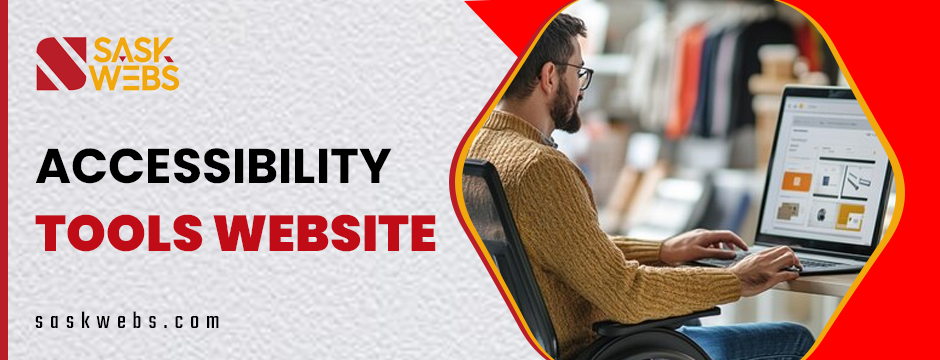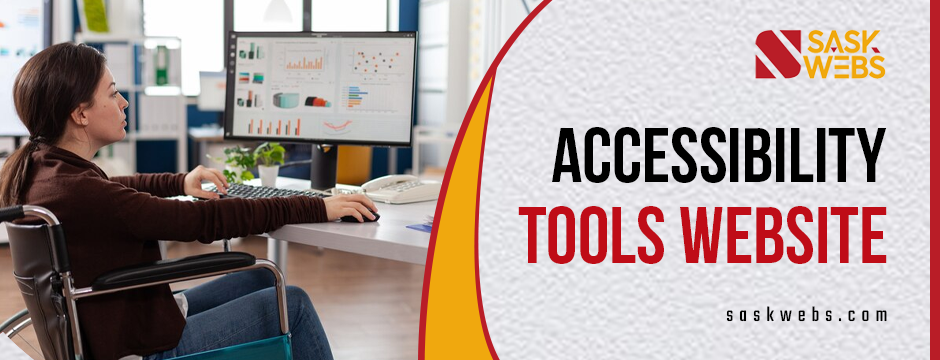
Websites serve as the gateway to information, services, and entertainment for millions of people across the globe. However, many websites unintentionally leave out a large group of people with disabilities. Ensuring that your website is accessible to everyone, regardless of their abilities, is a moral obligation and a legal one in many regions. This is where accessibility tools come into play.
In this blog, we’ll explore the importance of accessibility tools websites, the various tools available, and how they benefit users and website owners.
What Are Accessibility Tools for Websites?
Accessibility tools are features or software that help make online content easier to use for people with disabilities. Such as those who have trouble seeing, hearing, thinking, or moving. These tools include screen readers, voice commands, keyboard shortcuts, and options to adjust colours or contrast. The main goal is to make the web easier for everyone to access and use.
The Need for Website Accessibility
Before delving into the specific tools, it’s important to understand why accessibility is essential. There are several key reasons why website owners must prioritize accessibility:
1. Legal Compliance
Many nations have laws and regulations for websites to meet certain accessibility standards. In the United States, the Americans with Disabilities Act (ADA) mandates that websites should be accessible to people with disabilities. Similarly, the European Union has enacted the Web Accessibility Directive, which applies to public sector websites. Non-compliance with these regulations can lead to lawsuits, fines, and reputational damage.
2. Broader Audience Reach
By making your website accessible, you’re opening the door to a larger audience. According to the World Health Organization, over 1 billion people worldwide live with some form of disability. Failing to accommodate their needs means alienating a significant portion of the population. Accessible websites ensure that everyone has abilities, and can navigate and engage with your content.
3. Improved User Experience
Accessibility tools don’t just benefit users with disabilities. They also enhance the overall user experience. Features such as text resizing, keyboard shortcuts, and clearer navigation can make websites more user-friendly for everyone, including those who may not have a disability but prefer a more streamlined browsing experience.
4. SEO Benefits
Search engines, like Google, are easy to guide and provide a positive user experience. Accessibility features, such as alt text for images and proper heading structures, not only help users with disabilities but also improve your website’s search engine optimization (SEO). This means accessible websites are more likely to rank higher in search results by increasing visibility and traffic.
Key Accessibility Tools for Websites
Now that we understand the importance of accessibility tools websites. Let’s explore some key tools that can be implemented to make your website more inclusive.
1. Screen Readers
Screen readers translate the digital text into spoken words. It helps users with visual impairments to operate websites. Popular screen readers can enable them to understand and interact with web content. Screen readers rely heavily on properly structured websites. So it’s crucial to use semantic HTML, which helps these tools interpret the content correctly.
2. Keyboard Navigation
Many users with motor impairments rely on keyboard navigation to browse websites. Ensuring that all interactive elements on your site (such as menus, links, and buttons) can be accessed via the keyboard is essential for accessibility. Simple keyboard commands, like “Tab” to move between links and “Enter” to select them, allow users to navigate without a mouse.
3. Text Resizers
Text resizers are helpful for users to increase or decrease the font size of the content displayed on a website. This is particularly useful for users with visual impairments or age-related vision problems. It provides easy font adjustment options and ensures that text remains readable for all visitors.
4. Colour Contrast Adjusters
Colour contrast is crucial for users with visual impairments, especially those with colour blindness. Accessibility tools like colour contrast adjusters allow users to modify the contrast between text and background to make content more readable. The Web Content Accessibility Guidelines (WCAG) recommend a minimum contrast ratio of 4.5:1 for normal text to ensure legibility.
5. Closed Captions and Transcripts
For users with hearing impairments, providing closed captions for video content and transcripts for audio content is essential. Closed captions provide a text representation of the spoken words in videos, while transcripts allow users to read the content of audio recordings. These tools improve accessibility by providing multiple ways to consume content.
6. Accessible Forms
Online forms are a crucial component of many websites, from contact pages to checkout processes. However, forms can be challenging for users with disabilities if they are not properly designed. Accessibility tools like label tags, error messages in text, and easy-to-navigate form fields can make forms more accessible. Ensuring that all form elements are properly labelled and can be accessed via keyboard navigation is critical for usability.
7. Voice Recognition Software
For users with motor disabilities, voice recognition software allows them to control a website using their voice instead of a mouse or keyboard. Tools like Dragon NaturallySpeaking enable users to navigate websites, click on links, and enter text through spoken commands. Implementing voice commands can create a hands-free browsing experience, making your website more inclusive.
Benefits for Website Owners

Beyond serving the needs of users with disabilities, accessibility tools offer several benefits to website owners as well.
1. Increased Traffic and Engagement
As mentioned earlier, accessible websites reach a broader audience. By accommodating users with disabilities, you’re increasing the potential for more traffic and engagement. Accessible websites also encourage longer visit durations and lower bounce rates since they offer a more comfortable user experience.
2. Better Brand Reputation
By showing that you care about inclusivity, you enhance your brand’s reputation. Businesses that prioritize accessibility are often viewed more positively by consumers, which can lead to increased customer loyalty and trust.
3. Future-Proofing Your Website
Technology is constantly evolving, so accessibility is important to us. By implementing accessibility tools now, you’re ensuring that your website remains compliant with future regulations and continues to offer a user-friendly experience as new accessibility challenges arise.
Conclusion
Adding accessibility tools websites is important for following laws. It also helps create a more welcoming online space for everyone. By making your site easy for people with disabilities, you can reach a larger audience, improve the experience for all users, and boost your search rankings. Tools like screen readers, keyboard navigation, and colour contrast adjusters help users use your website. For website owners, the benefits include more visitors, a better reputation, and preparing your site for future changes. In today’s world, accessibility is a must, not just a choice.
Ensure your website is accessible to everyone with Saskwebs‘ to make your site inclusive, user-friendly, and compliant with global standards.






